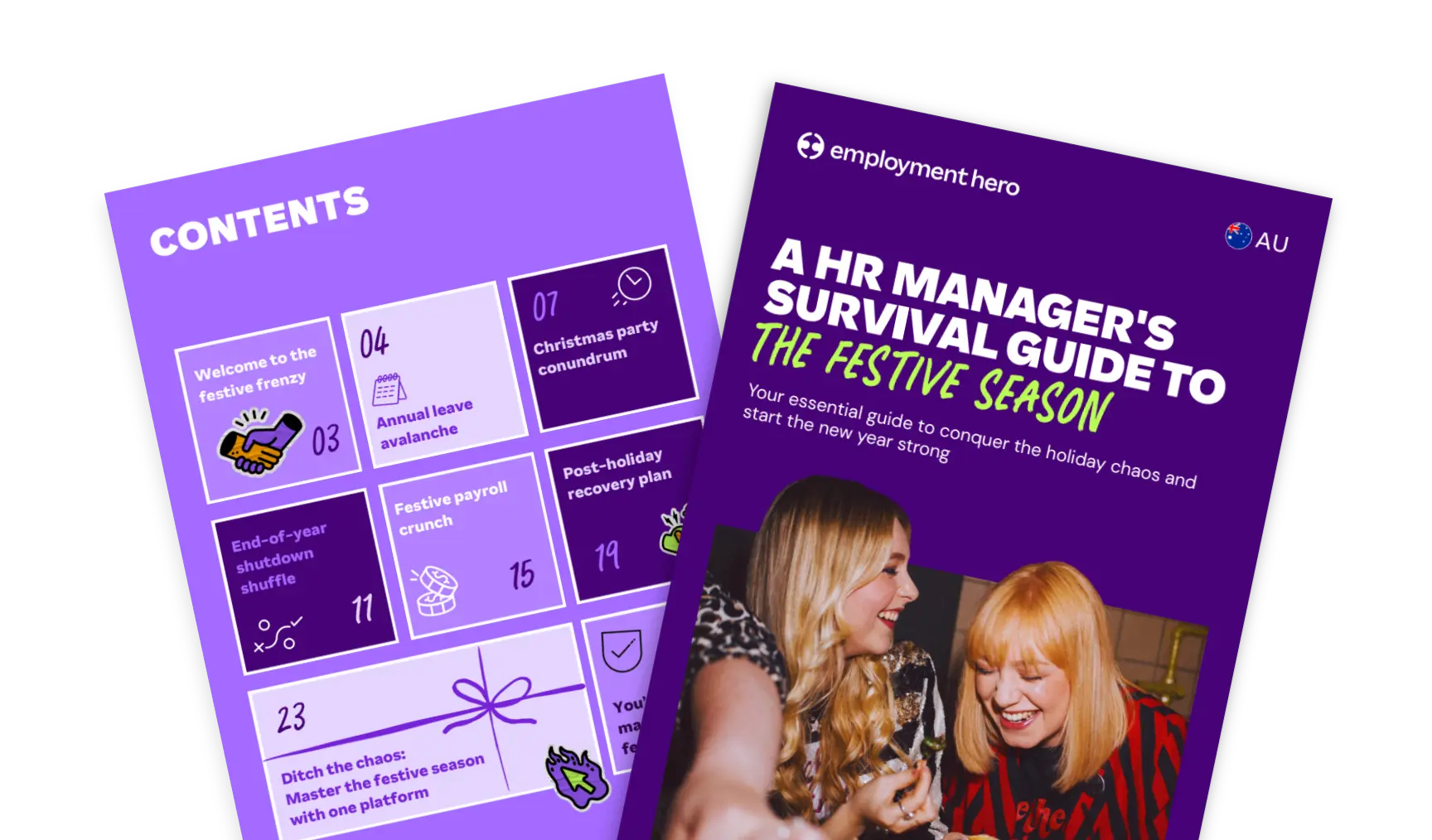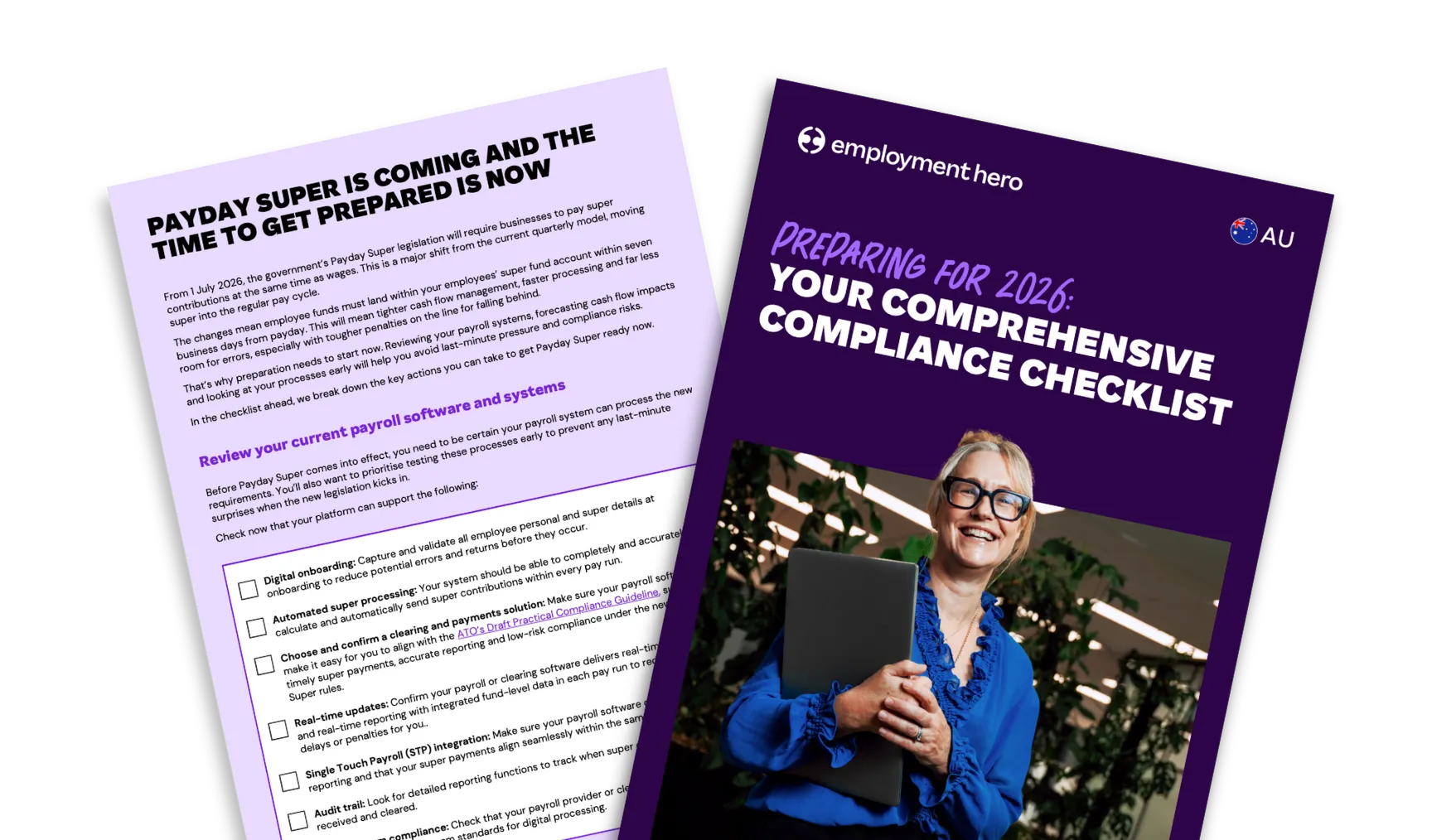Understanding the role of AI in the workplace

Are you ready to transform how your team works with artificial intelligence? Whether you’re just beginning to explore workplace AI or your organisation is already deeply immersed in these technologies, your role as an HR leader in shaping how these tools support knowledge workers (your team) and enhance company culture has never been more crucial.
What is included in this webinar?
AI systems are everywhere in today’s workplace, and you need practical advice on making them work for your team, not against it. This guide cuts through the confusion to help you implement artificial intelligence and deliver those actionable insights everyone’s talking about.
We’ll cover:
- Understanding workplace AI: Gain clarity on what artificial intelligence actually means for your organisation and how it differs from traditional HR software.
- AI applications for HR Teams: Discover how generative AI and machine learning can transform routine tasks like data collection and enhance decision-making processes.
- Cultural impact assessment: Learn strategies for introducing AI tools while preserving and strengthening your company culture and supporting your team.
- Generative AI fundamentals: Explore how these systems can assist with content creation, generate ideas and provide novel solutions to complex challenges.
By the end of this guide, you’ll have the confidence to implement workplace AI that genuinely supports your people and business goals.
What is workplace AI?
Workplace AI simply means using artificial intelligence tools to help your team work better and smarter by handling routine tasks, spotting patterns in data and even generating new ideas.
Unlike traditional software that just follows set instructions, workplace AI uses machine learning and natural language processing to adapt and improve over time. It can process information in ways that feel almost human, but much faster and on a much larger scale.
However, while most leaders agree that artificial intelligence is essential for business today, many organisations lack a clear plan for moving beyond individual experiments to company-wide implementation that actually impacts the bottom line. That’s where your HR team comes in.
As an HR leader, you need to understand that workplace AI isn’t just another tech trend; it’s changing how work happens. The best AI tools complement your existing business practices while supporting your employees rather than replacing them. With thoughtful implementation, these technologies can reduce human error while preserving what makes your company culture special.
What common tasks can AI complete for businesses?
AI tools can transform everyday operations across your organisation, handling a variety of essential but time-consuming tasks that previously required significant manual effort.
Below are a few examples of how AI solutions can create practical value for your team.
Using AI tools for data collection
Artificial intelligence can revolutionise how your organisation gathers, processes and utilises data. These systems can automatically extract information from multiple sources, standardise formats and create unified databases that make information accessible when and where it’s needed.
For Australian businesses managing complex compliance requirements, AI tools can continuously collect regulatory updates, customer feedback and market trends without requiring staff to monitor multiple sources manually. This allows your team to focus on analysing insights rather than gathering them.
This technology is particularly valuable for organisations with distributed teams across different states and territories, as it ensures consistent data collection practices regardless of location.
Using AI tools for routine tasks
Your team likely spends considerable time on necessary but low-value activities that don’t require human judgment or creativity. Workplace AI can take over these routine tasks, handling everything from scheduling and basic correspondence to data entry and report generation.
The average employee spends nearly two hours daily, if not more, on administrative work that could be automated. Artificial intelligence can handle email filtering, meeting scheduling, document formatting and basic information requests; giving your people back valuable time for work that actually requires human skills.
When managing international relationships, artificial intelligence systems can automatically schedule meetings at convenient times, translate communications and maintain records without requiring your staff to work outside business hours.
By delegating these predictable tasks to AI tools, you free your people to focus on activities that truly benefit from human touch, enhancing both productivity and employee morale.
Using AI tools to reduce human error
Even your most diligent team members make mistakes, particularly when handling repetitive tasks or working with complex data sets. Artificial intelligence maintains consistent accuracy regardless of volume or complexity, significantly reducing error rates in critical business processes.
For companies managing sensitive information under privacy regulations, machine learning systems can verify compliance, flag potential issues and ensure consistent application of standards. This reduces both the risk and consequences of human error in data handling.
Using AI to enhance communication
Natural language processing allows AI systems to improve communication across your organisation. From drafting consistent internal announcements to summarising lengthy reports, these tools help ensure your messages are clear, concise and appropriate for their intended audience.
These systems can also help standardise your company communications, ensuring consistency in tone and messaging while still allowing for personalisation when needed.
Using AI for actionable insights
Beyond automating existing processes, workplace AI can transform how your organisation discovers valuable information hidden within your existing data. These systems excel at identifying patterns that might otherwise go unnoticed.
Your team can use artificial intelligence to analyse meeting minutes to identify recurring operational issues, track project progress across departments without manual status reports or detect early warning signs of production bottlenecks.
The technology can also examine customer interactions to highlight product features that consistently receive positive feedback or pinpoint common pain points that might warrant attention.
How to create a phased workplace AI implementation plan
Successfully introducing artificial intelligence into your workplace requires a structured approach that reduces disruption while delivering maximum benefits. Begin by conducting a practical assessment of which functions would benefit most from AI automation, focusing on high-volume routine tasks with clear processes and measurable outcomes.
- Start with small-scale pilot programmes rather than organisation-wide deployments. Select a specific department or team that’s open to change and has clearly defined processes that artificial intelligence could enhance. This allows you to gather feedback, refine your approach and demonstrate tangible benefits before expanding further.
- Define clear success indicators tailored to your organisation’s size and industry. For a smaller business, success might mean reducing administrative time by 15-20%, while larger enterprises might focus on more complex metrics like improved decision consistency or knowledge worker satisfaction. Document both quantitative improvements (time saved, error reduction) and qualitative benefits (employee morale, work quality) to build a compelling case for wider implementation.
- Create a realistic timeline that acknowledges the learning curve associated with workplace AI adoption. Most successful implementations follow a 3-6 month pilot phase, followed by staged rollout across departments, with full integration typically requiring 12-18 months depending on organisational complexity.
While implementing your AI strategy, remember that compliance requirements vary significantly across industries and regions and will shape how you can responsibly deploy workplace AI.
Taking time to understand these obligations at the outset prevents costly adjustments later and builds trust with both employees and customers.
How does AI impact company culture?
Introducing artificial intelligence into your workplace goes far beyond implementing new systems; it fundamentally shifts how people work, collaborate and feel about their roles.
The way you manage this transition can either strengthen your company culture or seriously undermine it. Finding the right balance is essential for maintaining both operational effectiveness and employee wellbeing.
Preventing anxiety around AI to maintain employee morale
Employees often worry that workplace AI will make their roles redundant or devalue their contributions. This anxiety can significantly damage employee morale if not properly addressed. Clear communication about how artificial intelligence will augment rather than replace human work is essential.
Set explicit boundaries around AI usage in your organisation. Define which tasks are appropriate for AI systems (routine tasks, data collection, initial drafts) and which require human judgment (final decisions, sensitive conversations, creative direction). This clarity helps prevent both underutilisation and overreliance on the technology.
Create opportunities for your team to experiment with AI tools in low-pressure situations. When people directly experience how these systems help them work more effectively, anxiety often transforms into enthusiasm for the possibilities these technologies offer.
Using AI tools to improve the employee experience
Artificial intelligence can significantly enhance how people experience their daily work. By handling repetitive administrative burdens, AI systems free employees to focus on aspects of their roles they find genuinely satisfying, for example, creative problem-solving, relationship building and strategic thinking.
Consider how workplace AI can personalise learning and development. Machine learning algorithms can identify individual skill gaps, recommend targeted training resources and adjust recommendations based on progress and feedback, creating more engaging development experiences.
AI tools can also improve collaboration by capturing, organising and making accessible the collective knowledge of your organisation, creating a more connected and efficient workplace where information flows more freely.
Preserving human connection while addressing ethical considerations
While artificial intelligence excels at optimising processes, company culture thrives on genuine human connections. Be intentional about which communication channels should remain primarily human-driven, such as team check-ins and career discussions that benefit from empathy and nuance.
Engage your entire organisation in conversations about ethical AI use. Create structured opportunities for the team to contribute to guidelines around data usage, privacy considerations and potential biases in AI systems. This collaborative approach demonstrates respect for employee perspectives while producing more robust ethical frameworks.
Regular ethics reviews should become part of your governance process, ensuring that as workplace AI evolves, it continues to align with your organisation’s values while preserving meaningful human interaction at the heart of your company culture.
Adapting leadership styles for AI-enhanced workplaces
As workplace AI transforms how teams operate, leadership approaches need thoughtful adjustment. Effective leaders in AI-enhanced environments shift their focus from monitoring routine tasks to providing strategic direction, encouraging innovation and developing their people’s capabilities.
This transition requires developing new skills, like learning to distinguish which decisions benefit from AI support versus human judgment, understanding the strengths and limitations of various artificial intelligence tools and successfully integrating technological capabilities with human insight.
Leaders should demonstrate balanced technology adoption, showing both confidence in using AI systems and discernment about when human experience should take precedence, establishing healthy norms that others throughout the organisation can follow.
Measuring cultural impact alongside operational metrics
When assessing your AI implementation, look beyond efficiency statistics to evaluate effects on company culture. Regular pulse surveys can help track changes in employee engagement, workplace satisfaction and attitudes toward artificial intelligence adoption across your organisation.
Watch carefully for signs that workplace AI might be creating unintended divisions; whether between teams with different levels of AI access or between colleagues with varying degrees of technical confidence and capability.
Use these cultural indicators as early warning signals that your implementation approach may need adjustment, allowing you to address concerns proactively before they significantly impact employee morale or damage your company culture.
Successfully integrating artificial intelligence into your company culture requires thoughtful planning, clear communication and ongoing adjustment based on feedback from your team. The goal isn’t to maximise AI usage but to find the optimal balance that enhances both operational effectiveness and employee experience.
For organisations already using our platform, our HR advisory service can provide tailored guidance on cultural integration strategies specific to your workplace
What is generative AI?
Generative AI refers to artificial intelligence systems that can create new content, including text, images, code and audio, that wasn’t explicitly programmed into them (think ChatGPT and the likes). Unlike traditional AI that follows strict rules to perform specific tasks, generative AI can produce original outputs based on patterns it has learned from vast amounts of existing data.
While conventional workplace AI might help you analyse information or automate routine tasks, generative AI can actually create something new. It’s the difference between a calculator that solves equations and an assistant that writes an entire email draft for you based on a few bullet points.
For employers and employees alike, generative AI serves as a collaborative partner that drafts communications, generates ideas, summarises documents and handles tedious writing tasks. This allows employees to focus on refining content and applying their uniquely human judgment rather than starting from scratch.
The real value comes from finding the right balance, using these artificial intelligence tools for initial content creation while maintaining human oversight for quality control and strategic decisions.
Which AI systems can benefit businesses?
Different types of artificial intelligence tools offer distinct advantages depending on your organisation’s needs and challenges. Understanding these options helps you prioritise investments that deliver the greatest value.
Process automation AI excels at handling structured, repetitive tasks that follow consistent rules. These systems can transform data entry, invoice processing, appointment scheduling and other routine tasks that consume valuable time. By delegating these predictable activities to AI tools, you free your team to focus on higher-value contributions.
Analytical AI helps organisations make sense of large volumes of data to identify patterns and generate actionable insights. These systems can analyse customer behaviour, operational efficiency or employee performance to uncover opportunities for improvement that might otherwise remain hidden.
For example, our SmartMatch by Employment Hero, uses analytical AI to solve one of hiring’s most persistent challenges: accurately connecting qualified candidates with suitable positions. For employers, this means finding genuinely suitable candidates rather than just those who optimised their applications with the right keywords.
The system leverages insights from millions of employees and hundreds of thousands of businesses worldwide, offering transparent, real-time salary data across different regions and occupations to help both sides make informed decisions.
Conversational AI manages interactions with employees and customers through natural language processing. From answering common HR questions to guiding employees through benefit selection, these systems provide consistent, accurate responses while reducing the burden on support teams.
The most sophisticated versions can understand context, remember previous interactions and continuously improve their responses based on feedback.
Decision support AI augments human judgment in complex situations by providing relevant information, highlighting important factors and suggesting potential approaches. These systems don’t replace decision-makers but enhance their effectiveness by ensuring they consider all relevant information.
For HR leaders making decisions about workforce planning, compensation strategy, or development investments, these tools provide valuable context and reduce unconscious biases.
How do you establish responsible governance with workplace AI?
As artificial intelligence becomes part of your everyday operations, you’ll need clear rules for how it’s used. Think of this as creating guardrails that keep your AI implementation on track while protecting what matters most to your organisation.
- Define who makes the decisions about adopting new AI tools. Create straightforward criteria for approval that consider both the benefits (like time saved) and potential risks (like data security concerns). This prevents the “wild west” scenario where different departments implement conflicting systems.
- Be crystal clear about data usage. Create specific policies that explain what information your AI systems can access, how it’s stored and how it’s protected. Then make sure your team understands these policies, especially when the systems handle personal or performance information that people naturally feel sensitive about.
- Create oversight that doesn’t slow you down. Instead of bureaucratic approval processes that frustrate everyone, focus on clear principles and practical guidelines that help teams make good decisions about AI applications. Consider forming a small, diverse team with members from HR, IT, legal and operations to evaluate significant new implementations.
- Connect with what you already have. Rather than creating an entirely separate governance system for AI, integrate these new guidelines with your existing technology and data frameworks. This approach makes compliance more straightforward and feels like a natural extension of processes your team already understands.
When done right, AI governance doesn’t restrict innovation, it enables more confident adoption by providing a trusted framework that both protects your organisation and empowers your people to embrace artificial intelligence tools.Choosing the right all-in-one HR software is crucial to successful AI implementation in your workplace. The best platforms will offer both powerful artificial intelligence tools and the frameworks to deploy them ethically, ensuring you can confidently embrace these technologies without compromising on security or compliance.
Meet your hosts
Watch the webinar
Related Resources
-
 Read more: HR Managers: Don’t just survive the festive season, master it
Read more: HR Managers: Don’t just survive the festive season, master itHR Managers: Don’t just survive the festive season, master it
Make year-end easier: manage leave, payroll, parties and shutdowns with confidence. Get practical tips for Australian SMEs. Download the free…
-
 Read more: Preparing for 2026: Your Compliance Checklist
Read more: Preparing for 2026: Your Compliance ChecklistPreparing for 2026: Your Compliance Checklist
Get your business ready for the 1 July 2026 changes. See practical steps for Payday Super, cash flow planning and…
-
 Read more: Monthly business budget template for employers
Read more: Monthly business budget template for employersMonthly business budget template for employers
Plan your monthly income and expenses with our free monthly business budget template. Download today to track cash flow and…


























